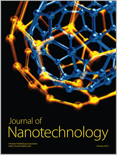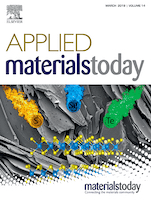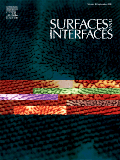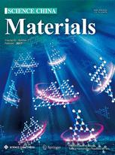
BULLETIN OF MATERIALS SCIENCE
Scope & Guideline
Advancing the Frontiers of Materials Science
Introduction
Aims and Scopes
- Materials Synthesis and Characterization:
This area encompasses various methods for synthesizing materials, including chemical, physical, and biological techniques. Studies often focus on the structural, optical, and electrical characterization of these materials to understand their properties better. - Nanomaterials and Nanocomposites:
Research in this field emphasizes the development and application of nanostructured materials, including nanoparticles, nanofibers, and nanocomposites, exploring their unique properties for applications in electronics, energy storage, and environmental remediation. - Energy Storage and Conversion:
The journal covers advancements in materials used for energy applications, including batteries, supercapacitors, and fuel cells. This includes research on novel materials to improve energy efficiency, storage capacity, and sustainability. - Biomaterials and Biomedical Applications:
This scope includes studies on materials designed for medical applications, such as drug delivery systems, tissue engineering, and antimicrobial coatings, highlighting the intersection of materials science and health. - Environmental Materials Science:
Research in this area focuses on materials that address environmental challenges, including photocatalysis for pollutant degradation, materials for water purification, and sustainable materials development. - Functional Materials:
This involves the study of materials with specific functional properties, such as magnetic, electronic, or optical characteristics, and their applications in devices like sensors, transistors, and photovoltaic cells.
Trending and Emerging
- Green and Sustainable Materials:
There is a growing emphasis on eco-friendly and sustainable materials, including biodegradable polymers and materials synthesized using green chemistry methods, reflecting a broader commitment to environmental sustainability. - Advanced Energy Storage Solutions:
Research is increasingly focused on next-generation energy storage materials, such as solid-state batteries and supercapacitors utilizing novel nanomaterials, driven by the need for improved energy efficiency and safety. - Biomedical Materials and Drug Delivery Systems:
The development of advanced biomaterials for drug delivery and tissue engineering is a rapidly growing area, with research focusing on biocompatibility, controlled release mechanisms, and multifunctional capabilities. - Smart and Functional Coatings:
Emerging studies on smart coatings, including self-healing and anti-fogging properties, are gaining traction, highlighting the demand for materials that respond dynamically to environmental stimuli. - 2D Materials and Their Applications:
The exploration of two-dimensional materials, such as graphene and transition metal dichalcogenides, is trending due to their unique properties and potential applications in electronics, sensors, and energy devices. - Machine Learning in Materials Science:
There is an increasing integration of machine learning techniques in materials research, particularly in the design and discovery of new materials, optimizing properties through computational methods.
Declining or Waning
- Traditional Bulk Materials:
There has been a noticeable decline in studies focused solely on traditional bulk materials, as research increasingly emphasizes nanostructured and advanced materials with tailored properties for specific applications. - Conventional Energy Materials:
Research on conventional energy materials, such as traditional lithium-ion battery components, is waning in favor of innovative materials and technologies that promise greater efficiency and sustainability. - Basic Theoretical Studies:
While theoretical studies are essential, there is a shift towards more applied research that integrates theoretical insights with experimental validation, leading to fewer purely theoretical papers being published. - Single-Function Materials:
The trend is moving away from materials designed for single functions towards multifunctional materials that can address multiple challenges simultaneously, resulting in fewer publications on single-function materials.
Similar Journals

Journal of Nanotechnology
Unveiling the Potential of NanotechnologyThe Journal of Nanotechnology, published by Hindawi Ltd., is a premier open-access platform dedicated to delivering high-quality research in the dynamic field of nanotechnology. With the ISSN 1687-9503 and E-ISSN 1687-9511, this journal has been at the forefront of disseminating innovative findings since its transition to open access in 2009, fostering a global dialogue among researchers, professionals, and students. Based in Egypt, the journal maintains its commitment to advancing the material science sector, currently holding a prestigious Q2 ranking in the 2023 Materials Science (miscellaneous) category, reflecting its significant contribution to the field. With a Scopus ranking of #162 out of 463 journals in General Materials Science, placing it in the 65th percentile, the Journal of Nanotechnology serves as a crucial resource for those looking to explore the latest advancements and applications in nanomaterials. The journal invites submissions that align with its scope, which emphasizes interdisciplinary approaches and novel methodologies, promising to enhance both academic and practical aspects of nanotechnology.

Applied Materials Today
Advancing the Frontiers of Materials Science.Applied Materials Today is a leading peer-reviewed journal published by ELSEVIER, dedicated to the field of materials science. With an impressive impact factor and ranked in the Q1 category for materials science (miscellaneous) in 2023, this journal stands out as a crucial platform for sharing groundbreaking research and innovative applications of materials. Based in the Netherlands, the journal has rapidly gained recognition, achieving a remarkable Scopus ranking of 41 out of 463, placing it in the 91st percentile among general materials science publications. Covering a broad range of topics, from the synthesis and characterization of materials to their practical applications, Applied Materials Today seeks to inspire and inform researchers, professionals, and students alike. Its commitment to disseminating high-quality, open-access content ensures that cutting-edge discoveries in materials science can be shared with a global audience, fostering collaboration and advancements in the field.

Advanced Materials Interfaces
Fostering Collaboration in Materials Engineering ExcellenceAdvanced Materials Interfaces is a premier journal dedicated to the exploration and advancement of materials science, with particular emphasis on the interfacial phenomena that govern the behavior of materials in various engineering applications. Published by WILEY in the United Kingdom, this Open Access journal, established in 2014, has quickly ascended to a Q1 category ranking in both Mechanical Engineering and Mechanics of Materials as of 2023, reflecting its significant influence and excellence in the field. With impressive Scopus Ranks, such as #81 out of 672 in Mechanical Engineering and #58 out of 398 in Mechanics of Materials, it serves as a vital resource for researchers and practitioners aiming to push the boundaries of materials innovation. The journal provides unrestricted access to its cutting-edge research, promoting collaboration and dissemination of knowledge among the global scientific community, solidifying its role as a vital contributor to the ever-evolving landscape of materials engineering.

Surfaces and Interfaces
Bridging Science and Technology at the Surface LevelSurfaces and Interfaces is a leading international journal published by Elsevier, dedicated to advancing the understanding of surface and interfacial phenomena across various disciplines, including chemistry, materials science, and physics. With an impressive impact factor placing it in the Q1 quartile for its categories as of 2023—spanning Chemistry, Condensed Matter Physics, and Surfaces, Coatings, and Films—this journal not only serves as a critical platform for innovative research but also reflects the dynamic nature of surface science in contemporary applications. The journal is indexed in Scopus, ranking 25th out of 132 in the Materials Science – Surfaces, Coatings and Films category, marking it in the top 19% of this prestigious field. Although it is not an open-access platform, the journal remains a vital source of curated academic material for researchers, professionals, and students seeking to deepen their knowledge and contribute to ongoing conversations in surface and interface science. Published from the heart of Europe in Amsterdam, Surfaces and Interfaces invites submissions that challenge conventional paradigms and explore the forefront of technology and materials.

JOURNAL OF MATERIALS SCIENCE
Connecting Ideas and Innovations in Materials ScienceJOURNAL OF MATERIALS SCIENCE, published by SPRINGER, stands as a highly regarded periodical in the field of materials science, delivering impactful research since its inception in 1966. With an impressive Q1 ranking in both Mechanical Engineering and Mechanics of Materials, alongside strong Q2 positions in Ceramics, Composites, and General Materials Science, this journal serves as a pivotal resource for scholars and practitioners alike. It offers insightful contributions that span a diverse range of topics, from emerging materials to advanced applications in engineering. With a robust Scopus ranking reflecting its global influence—ranking 91 out of 672 in Mechanical Engineering and 63 out of 398 in Mechanics of Materials—the JOURNAL OF MATERIALS SCIENCE maintains an essential role in advancing the understanding and innovation within the discipline. Researchers, professionals, and students are encouraged to access this esteemed journal to keep abreast of groundbreaking findings and methodologies that shape the future of materials science.

Nano Express
Advancing nanotechnology for a transformative future.Nano Express is an esteemed open-access journal published by IOP Publishing Ltd, dedicated to advancing research in the fields of nanotechnology and materials science. Since its launch in 2020, the journal has swiftly established itself as a vital resource for researchers and professionals, garnering significant recognition in various domains, including biomaterials, electronic, optical and magnetic materials, and polymers and plastics. With a commendable categorization in Scopus quartiles, it ranks in Q2 for Electronic, Optical and Magnetic Materials, and maintains a top percentile in several others, exemplifying its commitment to high-quality research dissemination. Located in the United Kingdom, this journal fosters a global dialogue among experts and newcomers alike, facilitating open access to innovative research that drives the future of nanotechnology. By offering a platform for groundbreaking studies and reviews, Nano Express aims to bridge the gap between theoretical understanding and practical application, championing the development of next-generation materials that have the potential to transform various industries.

Nano Materials Science
Advancing the Frontiers of Nanotechnology.Nano Materials Science is a premier open-access journal dedicated to the dissemination of groundbreaking research in the fields of nanotechnology, materials science, and chemical engineering. Published by KEAI PUBLISHING LTD, this journal has quickly established itself as a leading platform in its area since its inception in 2019, with impressive rankings in the Scopus database, holding a Q1 position across multiple categories, including Chemical Engineering and Materials Science. Based in Beijing, China, Nano Materials Science provides researchers and practitioners access to a wealth of high-quality peer-reviewed articles, fostering innovation and collaboration within the scientific community. With its impact factor steadily rising and a commitment to open access, the journal aims to bridge the gap between theoretical research and practical applications, making it an essential resource for professionals and students eager to stay at the forefront of materials research and nanotechnology advancements.

Science China-Materials
Innovating Tomorrow's Materials, Today.Science China-Materials is an esteemed peer-reviewed journal dedicated to advancing the field of materials science, published by SCIENCE PRESS. With a strong focus on innovative research and applications, this journal provides an essential platform for disseminating groundbreaking findings in materials development, characterization, and engineering. Since its inception, Science China-Materials has achieved an impressive Q1 ranking in the Materials Science (miscellaneous) category, reflecting its commitment to quality and the impact of its publications, as indicated by its 86th percentile ranking in Scopus. The journal is set to converge its contributions from 2016 to 2024, making it a vital resource for researchers and professionals interested in the latest advancements and trends in materials science. As an open access publication, it ensures that knowledge is freely available to a global audience, promoting collaboration and innovation across disciplines. The journal is headquartered in Beijing, China, and continues to attract high-quality submissions from leading experts in the field.

ADVANCED FUNCTIONAL MATERIALS
Shaping the Future of Materials Through Rigorous ResearchADVANCED FUNCTIONAL MATERIALS is a leading journal published by WILEY-V C H VERLAG GMBH, prominently recognized in the fields of biomaterials, chemistry, condensed matter physics, and materials science. With an impressive impact factor and a distinguished position in the Q1 quartile across multiple categories including nanoscience and nanotechnology, this journal serves as a vital platform for researchers and professionals committed to innovating in functional materials. Since its inception in 2000, ADVANCED FUNCTIONAL MATERIALS has published high-quality peer-reviewed articles that push the boundaries of materials science, exploring new frontiers in electronic, optical, and magnetic materials. The journal's dedication to open access ensures that its groundbreaking findings are readily available to a global audience, fostering collaboration and knowledge-sharing among scholars and practitioners in the field. For those seeking to stay at the forefront of materials research, ADVANCED FUNCTIONAL MATERIALS is an essential resource.

Emergent Materials
Transforming Challenges into Solutions in Material Science.Emergent Materials is a leading journal in the fields of biomaterials, ceramics, composites, and environmental science, published by SpringerNature. With an ISSN of 2522-5731 and an E-ISSN of 2522-574X, this journal serves as a crucial platform for researchers and professionals seeking to publish their findings on innovative materials that drive advancements across various applications. Renowned for its impactful contributions, Emergent Materials currently holds a Q2 ranking in Biomaterials and Waste Management, and a prestigious Q1 ranking in Ceramics and Composites for 2023, showcasing its excellence in these dynamic fields. Positioned within Switzerland, the journal supports a wide array of open access research initiatives, allowing for greater dissemination and accessibility of critical scientific knowledge. Spanning over the years 2018 to 2024, the journal aims to publish groundbreaking studies that address global challenges in sustainability, energy, and material disposal. With an impressive Scopus ranking highlighting its impactful presence, generate compelling insights and stay at the forefront of material sciences with Emergent Materials.